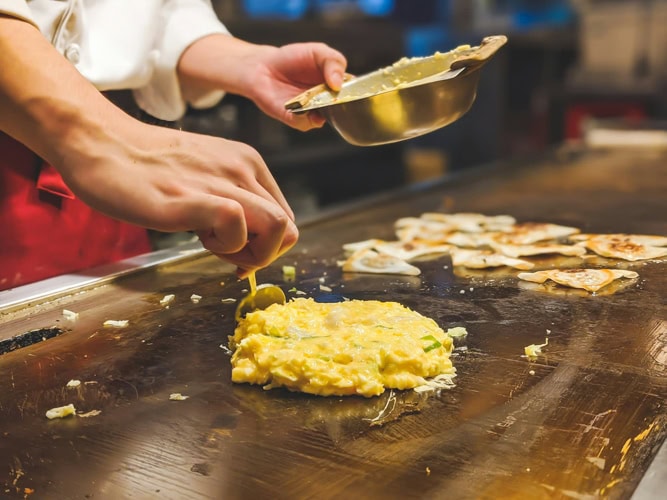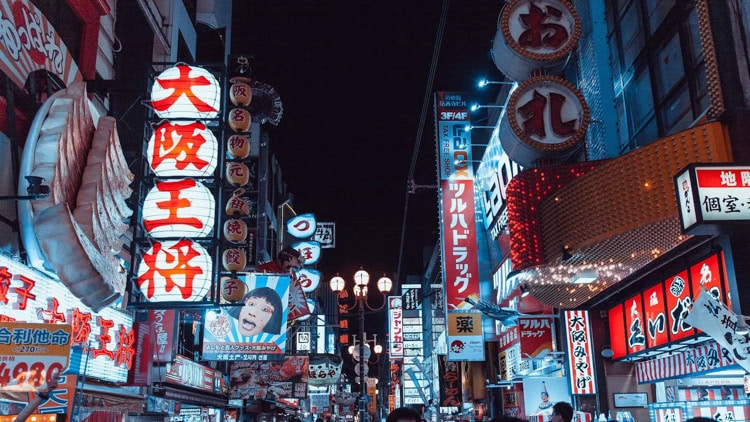
Go World Travel is reader-supported and may earn a commission from purchases made through links in this piece.
Choosing a favorite region in Japan is only slightly less difficult than choosing a favorite child. That may be a dramatic take, but each region is equally different and exciting. Unless you have an infinite budget or free time, you will need to narrow down your travel options.
You will never go wrong with choosing Kansai.
Wakayama prefecture has peaceful and beautiful beaches while Osaka has the neon lights and bustling crowds. Kobe has trendy cafes with sea views and Otsu has water sports on Japan’s largest lake. Nara has bowing deer and Kyoto has picturesque temples and shrines.
No two cities or even two prefectures in Kansai are alike. These 10 reasons will inspire any kind of traveler to head to Kansai ASAP.
1. Kansai Nature

You can hike, surf, kayak, camp, fish and swim at numerous locations around Kansai as you will never be too far from a mountain or body of water. The cherry blossom season attracts countless tourists, for good reason, but all seasons can be enjoyed in Kansai.
Walls of hydrangeas bloom in June at Hasedera temple in Nara prefecture. Head to a ski resort in Hyogo prefecture or Shiga prefecture during winter. Enjoy the fall foliage along the hiking trails of Minoh in Osaka prefecture.
Even if you stay in a city, you can search for a nearby park or botanical garden if you want to see some greenery.
Planning a last-minute trip to Japan?
Top Experiences and Tours in Japan:
- See the sights with a tour of Tokyo: Full-Day Private Tour with Nationally-Licensed Guide
- See Mount Fuji on the Private Full Day Sightseeing Tour to Mount Fuji and Hakone
- Explore more with this tour of Tokyo Half-Day Private Tour with Government-Licensed Guide
Where to stay in Japan:
- Find accommodation with Booking.com
- Find your dream apartment in Japan with Agoda
- Find a hostel in Japan with Hostelworld
2. Food in Kansai

Osaka is known as the kitchen of Japan with its savory takoyaki and kushikatsu in countless shops. Kobe beef is famous all over the world but Omi beef from Shiga prefecture can definitely compete.
The region also boasts akashi-yaki, green tea, kitsune udon, yatsuhashi, and Osaka style okonomiyaki.
Some restaurants will have order machines where you can peruse a menu in multiple languages and pay before getting your food. If you are feeling adventurous, you can hop into any long line of Japanese people waiting for a restaurant. You won’t regret trying a dish beloved by locals.
3. Dynamic Cities

Osaka is Kansai’s largest city and has all the shopping and nightlife you will ever need. Kyoto and Kobe also offer these conveniences with a slightly less frantic energy. Cities like Tsu, Nara, Otsu, and Wakayama are on the quieter side while still retaining many attractions and widespread transport.
If you love spending all your travel time exploring urban areas, you won’t run out of traditional markets, temples, department stores, restaurants or karaoke spots to visit. If you just want to make a brief stop in the big city, the countryside is always close.
4. Outgoing People

Japanese citizens often declare people from Kansai as the most outgoing among all the regions. Striking up conversations with a stranger in an izakaya (Japanese pub) is a common occurrence.
Any area of Japan is going to have impressive customer service and Kansai is no exception. Kansai shopkeepers and restaurant owners often give customers a bonus of friendly conversation and curiosity.
If you really want to get on people’s good side, go and support the Hanshin Tigers baseball team at Koshien stadium in Hyogo prefecture. You could meet lifelong friends if you let them know how much better the Hanshin Tigers are than the Tokyo Giants.
5. History of Kansai

Japanese society as we know it today started in Kansai. Japan’s first permanent capital was the city of Nara and Kyoto was Japan’s capital for over a thousand years. Both cities offer vast historic collections that could take years to explore.
Ise Shrine, a Shinto shrine dedicated to the sun goddess Amaterasu, is one of Japan’s holiest sites. This sacred place in Mie prefecture is said to have been established around 2,000 years ago.
Himeji Castle is Japan’s premiere architectural pride and a UNESCO world heritage site. Kobe’s port has seen goods from Chinese dynasties in the 700s to the first American traders in the 1800’s.
You can take a stroll down many random Kansai streets and be rewarded with a 100-year-old temple.
6. Public Transportation

Just about every major attraction in Kansai is accessible by train or bus. Renting a car is of course possible but becomes more of a hassle when you need to find parking in such a densely populated country. You can take the bullet train from Kyoto to Himeji, which are 130 km apart, in just 45 minutes.
If bullet trains are not in your budget, regular train lines cover the entire region. Once you get away from the major train hubs, there are still plenty of local buses to get you to more remote locations. Even the Wazuka tea farms in the misty countryside hills of Kyoto prefecture have bus stops.
While Japan does not have 24/7 running subway lines, the trains, buses and stations are clean and typically run on time. A train arriving or leaving late or early can even prompt an official apology from the railway company.
7. Affordability
Japan is easy to love until you get out your wallet.
Japan is not known as a budget backpacking paradise. However, accommodations are cheaper in the large Kansai cities than in Tokyo.
You can find hostels and guesthouses all over Kansai along with standard hotels. If you do want to splurge, a traditional ryokan in beautiful Toyooka, Hyogo can still be cheaper than a mid-range hotel in central Tokyo.
The bullet train will set you back, but you can get from city to city on cheaper express trains. Once you are finished sampling Kobe’s culinary scene, you can take a rapid train to Otsu, Shiga to check out Lake Biwa for 1500 yen (about 10 USD). That train trip takes you across two prefectures in one hour.
If there is a restaurant you really want to try, stop by at lunch to get discounted lunch specials.
8. Kid-Friendly

Universal Studios Japan is one of Osaka’s most popular attractions. If that does not appeal to your young travel companions, you can still find many zoos, aquariums, children’s museums and parks.
Kobe has the Animal Kingdom Zoo. Mie prefecture has the Suzuka Circuit Motopia amusement park. Trains and buses also have seating sections for travelers with young children.
With the majority of Japan’s population living in cities, there is always a need for kid-friendly activities and spaces in the Kansai metropolitan areas.
9. Go Off the Beaten Path

Kyoto gets plenty of tourists, but Awaji Island does not.
You can wow your friends with tales of hot springs in the mountains of Hyogo prefecture or the hiking pilgrimage Kumano Kodo in Wakayama prefecture. If you need to impress, use places in Japan that do not see many international visitors.
10. Or Enjoy Tourist Comforts

Not everyone wants to wander into a small Japanese town with no plans and no Japanese language skills. Straying too far from the beaten path stresses some travelers out. Who wants to be stressed on vacation?
There are tour options for many languages in cities like Osaka, Kyoto, and Nara. These cities also have more eating establishments with English menus. Wherever you go, train stations will always have their names displayed in Japanese and English to help you pinpoint your location.
Does your dream trip include being a beach bum, a tour of history museums, sampling a dozen ramen shops, or a day on a farm? If you visit Kansai, you can enjoy all of the above on one trip. Just bring your yen, an empty stomach, and the Japanese phrases for “thank you” (arigatou) and “delicious” (oishi).
Be sure to travel to Kansai with caution. Side effects of a trip include the desire to visit again and again.
If You Go:
Read More:
Author Bio: Sadie Welhoff grew up in the rural Midwest and after she finished her journalism degree, she jumped on a plane to teach English abroad. She has worked in South Korea and Thailand, went to language school in Taiwan, and is now working in Japan. When she isn’t enjoying trips on Japan’s wonderful train network, she is eating pasta or dreaming of living on a yak farm.
- Discover Claremont, California Along Historic Route 66 - December 6, 2024
- Three Sites to Soothe the Soul in Kyoto, Japan - December 5, 2024
- 13 Essential Tips For Women Traveling in Morocco - December 4, 2024

